Backwoods or bushcraft
In Scouting we use the term backwoods to describe somewhere away from towns or habitation. It’s more often used to describe an area of wild country usually within the woodlands of Canada or America, but could equally be used for areas like the Veldt or plains, the Australian bush or the vast forests of Europe. The craft of backwoodsmanship is the ability to live in harmony with nature in these out of the way places. This is done by living off the land, and adapting to the changing seasons, making yourself comfortable where others would find it difficult to survive, but its not survival.
In Scouting its camping away from a traditional campsite, with the least amount of equipment for your needs, cooking over fires and using natural materials wherever possible to make yourself comfortable, usually in the form of gadgets. As you become more experienced you can even make your own shelter, or in the summer months just sleep under the stars, the main thing is to enjoy yourself without the drudgeries of everyday living
.
How do we get started
.
First you must learn how to light a fire, there are a number of different ways to start a fire but for the beginner it’s best if you use matches. The number of people who say to me I can light a fire and then fail! never ceases to amaze me, fire lighting is something you must practice, and when I say practice this must be done under all whether conditions. The first thing you must get used to, is, it’s no use trying to cut corners, there’s a standard procedure for building a good fire, and if you stick to it you’ll never have any problems, regardless of the weather conditions so let’s look at what you must do.
Never light fires in an area where it is prohibited to have one. But you shouldn’t have any problems, having inspected your site before and made the necessary arrangements with the land owner so you can light one. First let’s look for the best place to build it, never build your fire on peaty soil, fire can travel great distances underground, and burn for years. And don’t build it under low lying trees, or near bushes, and shrubs, also be careful of tree roots close to the surface, the best place is somewhere void of any other combustibles, clear the area of dry grass and leaves etc. I prefer an area of green grass where I can take out a number of sods, to put back once I have finished. The art of having a fire is being able to leave it looking as though no one has been there. Ok you have found your site, and it complies with all the safety aspects, I was not going to mention this because I thought it was obvious, but having talked to a number of people apparently it’s not. When lighting, or working with a fire, never ware flammable clothing for obvious reasons, if in doubt read labels, or ask, usually manufacturers state if something is non flammable, but don’t take chances especially with children!
.
Lighting a fire with matches
.
Lighting a fire with a match, this is not as simple as it might seem; first there’s a number of different types on the market. Including safety matches, and so-called strike-anywhere matches, even storm proof matches, but whatever match you use, the same principle when using them apples. Having prepared your tinder and kindling, strike the match, the best way is to draw the match towards you with your middle finger supporting it at the back. This will help to stop it from braking. Contrary to what most people will tell you I have found this is the best way for me, normally you will be told to strike it away from you for safety reasons, but if you are careful and take your time this should not be a problem. (As long as you have remembered not to wear flammable clothing) Having ignited it, the flame must be shielded from the wind between both hands, (do not put the match box down at this stage) wait till the matchstick is burning, this is very important, its bad habit to try and ignite your tinder/kindling before the match is properly burning. At this point introduce the flame to the tinder/kindling, do not be tempted to push the match into it, because chances are you will snub the match, so be patient and wait till there is a good flame.
Once you are happy you have got your fire going, you can put your matches in a safe dry place, there is nothing worse than seeing someone put the matches down before the fires going, only to find they have been trodden into the ground, or the strikers got that wet it’s impossible to light another match, think safe. Also never leave your matches out to the elements overnight, there’s nothing worse than getting up in the morning, to find your only matches are damp from the morning dew or the previous night’s rain.
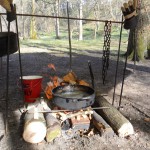
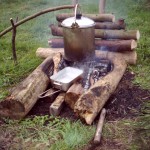

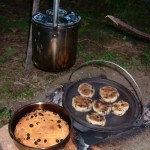
Kindling and Tinder
I have just mentioned tinder and kindling not thinking perhaps these things are alien to you, so with this in mind let’s look at them in turn.
Tinder or Punk, I am only going to talk about natural tenders, although there are a number of man-made chemical tenders, if you want to use these ‘that’s your choice.’ so let’s talk about natural tender/punk all tinder needs to be kept, and pardon the pun tinder dry, so always keep it in a suitable container otherwise it’s a waste of time collecting it. I am always on the lookout for suitable forms of tinder, and this is where preparation comes into its own, no matter what you are doing you can only get out what you put in, so be vigilant. One of the most common is wood shavings, and most woods will make tinder shavings as long as they are fine enough, but wood with a high concentration of resin is best, also dry decaying wood, Burch bark or scrapings, dry grass, beaten bark, seed heads, dried leaves, resin from pine trees, dried moss, and some forms of fungus. You can also use cotton wool, and char cloth, these are part man made, but they are not chemicals, char cloth you have to make yourself but is well worth it. First take some strips of cotton material, I use old shirts torn into strips and coiled, they are then packed in a small tin like a tight clock spring, I use a shoe polish tin. Next seal the lid and put a small hole in the top, now place the tin on a fire, smoke will start to come out of the hole in the lid, leave the tin on the fire until it stops smoking and then remove, once the tin has cooled down you will have a tin of char cloth. Kept dry it will never let you down.
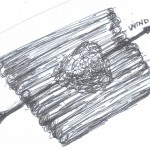
start with tinder as on left and then add kindling as on right
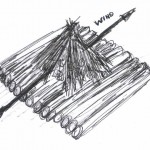
Loosely make a small raft of dry twigs the thickness of your finger, and place some tinder in the center now loosely build up a generous amount of kindling sticks the thickness of a match, remembering the fire triangle leave sufficient gaps to let the air in, with a space big enough on the windward side to insert your match.
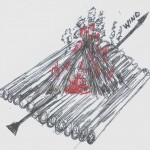
Add more kindling in pyramid shape or pigpen/log cabin as in picture
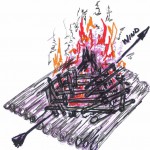
Some people prefer to build a pyramid shape, this works well and having made this first layer you can do a second layer of kindling slightly thicker, I like to lay a small amount of kindling around the tinder in the shape of a pyramid, but stack the second layer of sticks round the outside similar to a log cabin, or as some people call it a pigpen. Having set your fire, kneel down with the wind to your back, and insert a well-lit match (remember the paragraph on striking a match) into the gap you prepared in the kindling, and let the draft caused by the raft do the rest. When everything’s well alight you can start putting thicker twigs on, but keep the pyramid shape, don’t forget even at this stage it can still be smothered if you don’t provide sufficient ventilation
An alternative is, having built your raft, and prepared your kindling and wood as before. Have a large handful of bone dry matchstick size twigs ready, place your tinder in the center of your raft (this should be the size of a grapefruit) and ignite it with your flint or other, once its burning, split the handful of kindling in two, and place them to form a cross on top of the tinder. This should catch fire almost immediately, and once a good flame is going do the same again, but this time making a wigwam affect by crossing them from the opposite side. As the heat increases gradually ad more and more wood getting thicker until you’ve got a good fire going. Never be tempted to rush things, fire needs to grow at its own pace, and remember if it starts to fade you can increase the oxygen flow by fanning it.
The woodpile, gathering wood and preparing it for the fire is just as important as lighting the fire. I have been on backwoods cooking competitions with Scouts, where the wood gatherers have thought they had the least important job. When in fact without them, and there ability to fined suitable kindling to start the fire, and then having the foresight to collect sufficient, and suitable wood to keep it going. Without them doing this first the best, people you have to light the fire, prepare the food, and cook it, are of no use without the wood gatherer, having first collected the correct materials to start the fire. So having established the importance of gathering the correct wood for the job, we now need to determine what these woods are? Softwoods usually burn quicker and easier than hardwoods so are better for starting the fire. They’re also good for boiling and quick cooking but tend to give off sparks, usually they tend to be easier to cut and split, but this is not always the case. (Ho no it’s that dreaded list again) In alphabetical order softwoods Alder, Aspen, Cedar, Hawthorn, Horse Chestnut, Lime, Pine, Poplar, Spruce, Sycamore. Hardwoods burn longer and give off more heat making them ideal for worming cold nights; they also make good hot coals used when roasting. Hardwoods Apple, Ash, Beech, Birch, Sweet chestnut, Hazel, Holly, Hornbeam, Larch, Oak, and Willow. Having decided what’s what, it’s not quite as easy, as hard and soft woods; usually we have to do with whatevers at hand.
now let’s look at what you will want from a fire when it comes to cooking? As usual the number of people in your group will determine the type, and size of fire required, so with this in mind lets look at the basic requirements for cooking. Any fire will do for boiling water, all you need is sufficient heat to boil the water, but if you are cooking say a stew, in one pot, then once you’ve got it to the required heat, you must then simmer it, otherwise it will burn. If you were cooking on gas or electricity, you would turn the gas or electric down to achieve this, so what do you do when cooking on an open fire? Well you have two alternatives, one reduce the fire/heat, or two, lift it above the excessive heat that is causing it to boil, and the only way to do this is by razing the billy/pot above the flames, alternatively you can move it to one side, and basically that’s the secret to cooking on an open fire.
Instead of turning the heat down as in conventional cooking, when cooking on an open fire the only alternative is to lift the item you are cooking, above the flame. So with this in mind let’s look at how we can achieve this, first we must suspend our pots on something that we can lower, or lift, according to what we are cooking.
My favored method for hanging pots over the fire is three metal rods, instead of sticks, but obviously I only use this method on standing camps’ and I use builders line pins, or temporary fence pins, they are made out of lengths of bar with a hook, or a Y at the top that’s used for fastening the line/tape too. They make an excellent frame to hang your pots on, alternatively you can use green sticks with a Y shape at the top, I also suspend the pots from metal hooks fastened to a chain; again in a temporary camp you can use green sticks of an appropriate shape, see photo. Another alternative is flat metal bars to sit your pots on, or a crane, and as before you can use a metal rod for this, but as this type of hanger is normally used on a small temporary fire then you would be expected to use a suitable green branch. Another method used regularly on standing camps is a griddle, ether one that’s self-supporting or something similar to the ones used on BBQs that just sits on top of your fireplace.
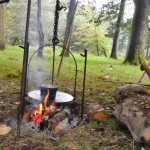

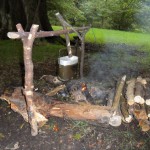
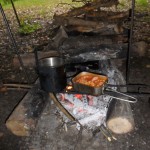
More about campfires and their uses
There’s something primeval about lighting a fire, and sitting around it at night, talking about the day’s events, whilst warming yourself, it’s both relaxing and reassuring, everyone wants to do it. But ask someone to light a fire and cook a meal, and you’ll get a different answer, and say to some people, cooking on camp can be just as enjoyable as the camping itself, and they’ll disagree. To them the whole aspect of cooking is something to be avoided at all cost, when in fact; if you do it properly it can be just as rewarding as that time spent sitting round the fire at night. So how do we disperse this feeling of dread when it comes to cooking? Well like most things it starts with a bit of preparation, (learning to walk before we can run.) There’s nothing worse than failing your first attempts, it can put you off cooking proper meals on an open fire for life. Cooking at camp is nothing like cooking at home in a kitchen, so to begin with start simple, and once you have mastered the basics, you can become a bit more adventures. It can be a simple thing at home on a Sunday morning to cook a full breakfast, but trying to do the same for say, seven or eight people, on a wet and windy Sunday morning at camp on an open fire, takes considerably more organization, and practical skills, never mined patience, and determination. Presumably you have all the appropriate utensils, and have mastered the art of lighting a fire, and are able to decide what type of fire best suits your needs, from the simplest, to the more complicated it’s your choice. Now all you have to do is develop your cooking skills by practicing, start with soups and stews, and once you become competent in these you can progress to something more adventures, but remember there’s no substitute for practice. Having mastered boiling etc you can then go on to roasting, and finally baking. A simple way of baking is by using a fire that reflects the heat into a pan positioned in such a way that it catches the heat from the fire; with this you can cook bannocks. Or if you want to be that more adventures you can use a reflector oven, which enables you to bake biscuits, or roast meat
An alternative to building the fire on the outside of your oven is, to construct one in such a way that enables you to set the fire within it, this is probably the most common way of heating an oven, although in a backwoods situation it’s the least one used, all commercial ovens are heated from within rather than outside. You can build a square oven type construction out of bricks, rocks, or stones, something similar to what you would build to form you’re grate but taller and filling in the gaps with clay, mud, and soil, but leaving a small opening at the front/windward end. Now build a fire inside this in the normal way and cover the top with a sheet of iron as used for the biscuit tin oven, but leave a gap to act as a chimney/flue to draw the fire. Now as the metal top gets hot, you can use this as a hot plate to cook things on in the same way they cook burgers etc, and you can keep the fire going by feeding it threw the hole at the front. What you want to do is heat the stones enough so that when you remove the fire, the temperature inside is sufficient to bake. This oven has the added bonus of keeping your pots simmering on the metal top, whilst you are roasting or baking items inside. When using the oven cover the hole at the front, and close the flue by sliding the metal top shut. The only thing against this type of oven is the amount of wood needed to heat the stones, looking for stones that will not crack or explode during heating, and not to forget that the top will burn you just the same as your food.
More about ovens
You can use a billy, a cast-iron pot, or an upturned bowl to bake or roast in for short camps, but always put whatever you are cooking, in a second container, and if possible lift it up on some stones or something to let the air circulate around it. Pile the ashes and fire all round the pots but don’t cover the top, unless you are using a Dutch oven specially made for this purpose, sometimes you can suspend the billy over the fire.
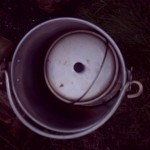
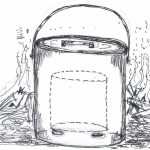
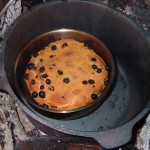
You can make an oven out of a biscuit tin, using the lid as a door, and you can make a handle from a small branch cut to size and bolted to the lid. You can make the shelf out of flat metal, or an old grill, or some square mesh, but bend the ends to support it. Alternatively have something made just for the job
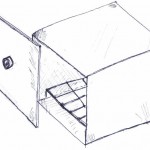
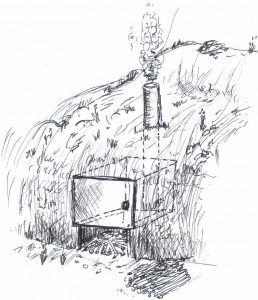
You can build your oven over a trench fire and vent it with a chimney, or build it into a small bank, and make the chimney out of old tins with the bottoms cut out stacked on top of each other, or use some metal pipe.
Another oven that is used all over the world, is one made entirely of clay, but because this type of oven takes a bit more time and preparation to make its only suitable for more permanent camps. Although it takes more time to make this oven its well worth making, and once made you will want to make more,
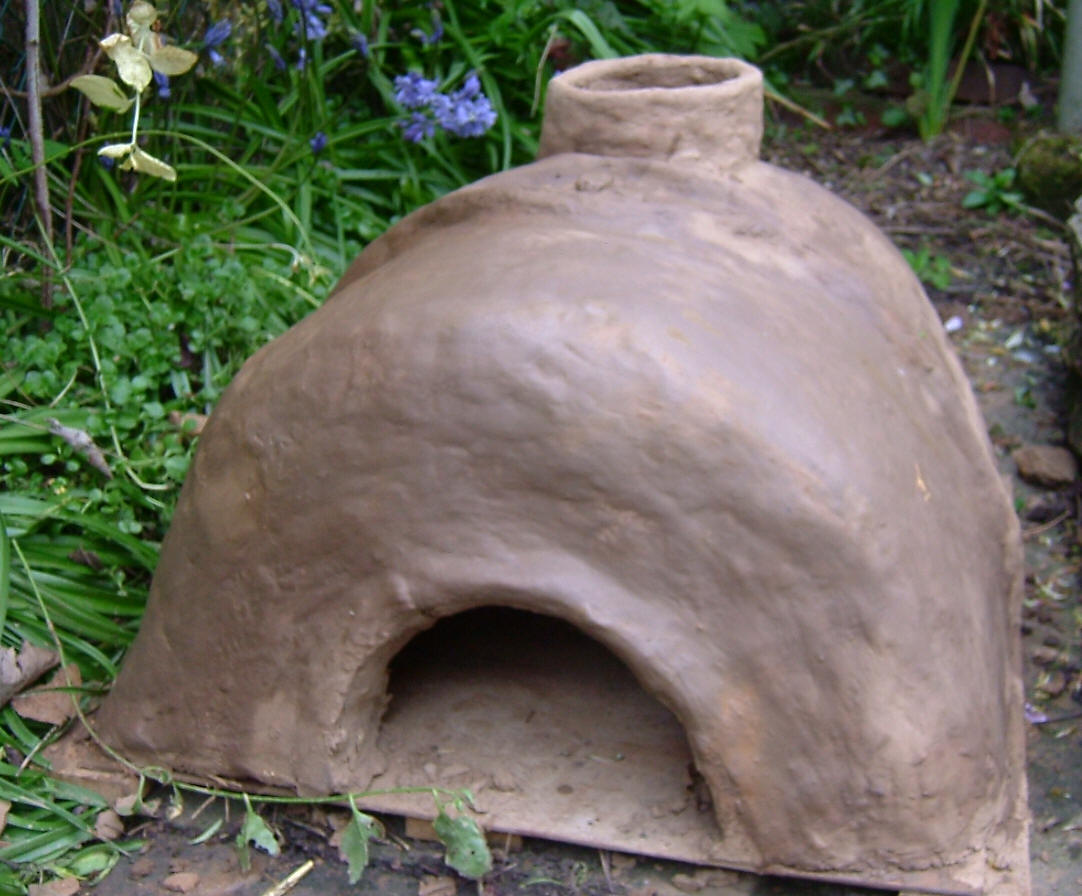
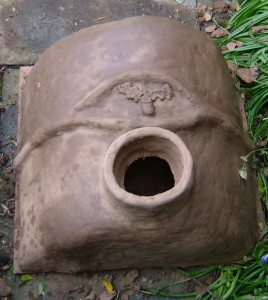
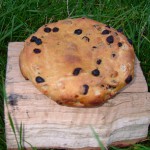
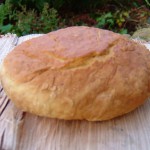
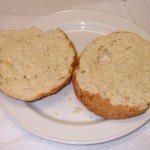
Just a couple of the things you can bake in your camp oven.
Warning
Activities involving all aspects of backwoods have the potential to be dangerous, especially those involving fires, and sharp tools, because of this, all health and safety precautions should be undertaken at all times. If you decide to replicate any of the activities, shown and described on these pages, they must be done under the supervision of a responsible instructor, and under no circumstances attempted by an untrained person. Because safe working can only be assessed on site by the person organizing the activity, no responsibility can be accepted for incidents arising from the use of this material.
